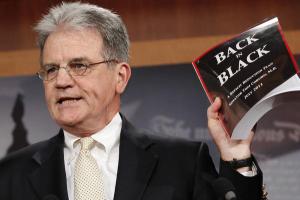
Sen. Tom Coburn, R-Okla. on Capitol Hill Monday, July 18, 2011 (Image Source: Associated Press)
By Greg Thielmann Senator Tom Coburn (R-Oklahoma) proposed a plan this week for reducing the deficit that includes $79 billion in cuts from the U.S. nuclear weapons budget over the next ten years. In specifying the individual components of a reduced strategic force structure, Coburn deserves credit for helping to break the strait jacket of Cold War thinking, which still burdens considerations of 21st century defense needs. As Ben Loehrke of the Ploughshares Fund noted in his July 19 analysis, Coburn's proposal "is already raising eyebrows around Washington." Whereas many in the Republican Party are reticent to consider reductions in the U.S. strategic nuclear arsenal below the ceilings established by the New Strategic Arms Reduction Treaty (New START), Coburn is proposing significant cuts in the arsenal. His "Back in Black" deficit reduction plan calls for "reduc[ing] the size of the nuclear weapons stockpile to levels within the [New] START treaty limits" by making the following changes:
- Reduce the size of the Intercontinental Ballistic Missile (ICBM) force from 500 to 300.
- Maintain a 1,100 nuclear weapon reserve.
- Reduce the size of the ballistic nuclear submarine fleet from 14 to 11.
- Maintain 40 strategic bombers and delay the purchase of new bombers until the mid-2020s.
The conservative Republican senator's questioning of prior nuclear orthodoxy may well be a harbinger. Others in his party are likely to join him in revolting against the nearly $200 billion price tag of modernizing the strategic arsenal and the nuclear weapons complex in the decade ahead. This is an especially appealing course for GOP fiscal hawks, who (unlike Coburn) are unwilling to contemplate revenue increases to close the deficit gap. Coburn's proposals are even more dramatic when one considers the timing of the cuts he is advocating. He is evidently suggesting a strategic delivery vehicle total of 560-604 missile launchers and bombers rather than the 800 allowed by the New START. This implies not only a deepening of the warhead and missile reductions envisioned by the treaty, but also an acceleration of the reductions already planned during the treaty's seven-year withdrawal period. It is not clear from his "Back in Black" deficit reduction plan what deployed warhead numbers would result from the specified actions, but if one assumes the ICBM and SLBM warhead loadings remain those currently planned, the speed and extent of the reductions (to 1,220 instead of to New START's 1,550) would be even more pronounced. Coburn's vote against New START ratification in December of 2010 enshrouds his new deficit reduction proposal in irony, for the entry into force of that treaty makes the strategic nuclear cuts he proposes much less risky. Without New START, Russia may well have slowed the retirement of its older, heavily-MIRVed ICBMs. Without the hundreds of notifications that have already occurred and the regular implementation of on-site verification measures under the treaty, the United States would have much less confidence in assessing the status of Russia's strategic forces. Coburn joins a growing chorus of defense analysts and military professionals who are re-evaluating Cold War assumptions that have long held sway against the emerging political, fiscal, and environmental realities. The 2007 Wall Street Journal op-ed of the "four horsemen" (Perry, Kissinger, Nunn, and Shultz), calling for a nuclear free world, gave a jump start to the reassessment process. Other notable milestones range from the Air Force Association recommending abandonment of the nuclear triad's bomber leg in a 2009 analysis to the JCS Vice Chairman's recent public conclusion that the United States does not have the money to recapitalize all three legs of the triad. For Sen. Coburn to enter the fray with a call for faster and deeper reductions than envisioned by New START powerfully legitimizes some additional hard thinking among Members of Congress across the political spectrum about how national security should be defined in the years ahead.
